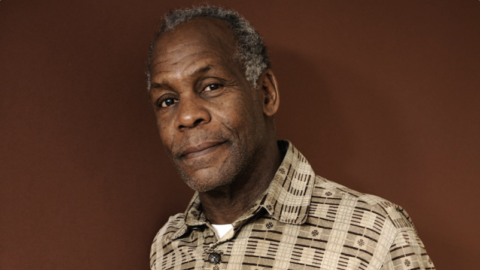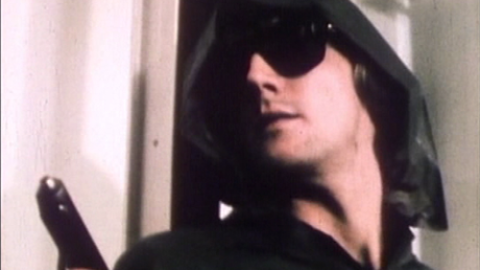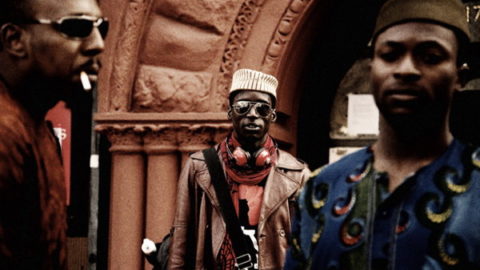Interview: Mbissine Thérèse Diop
Black Girl, directed by Ousmane Sembene, screens October 6 in the New York Film Festival, as one of the featured restorations by The Film Foundation’s World Cinema Project. The 1965 classic stars Mbissine Thérèse Diop as Diouana, a young Senegalese woman working as a housemaid who struggles after being brought to France. Livia Bloom spoke with the actress by phone.
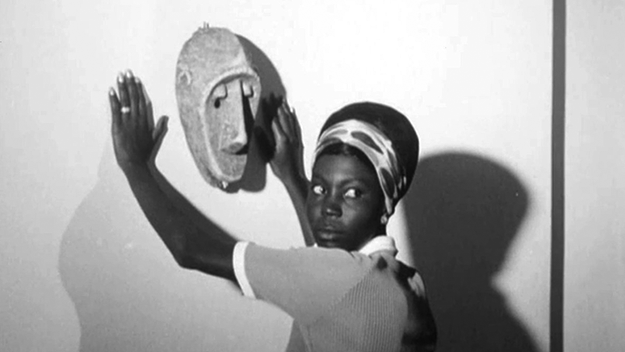
How did you meet Ousmane Sembene and become involved with Black Girl (aka La Noire de…)?
I didn’t go looking for Sembene. In Ivory Coast, a photographer and close friend who worked for the Senegalese news photographed me; Ousmane Sembene then saw my photograph. After seeing my photo and discussing me with my photographer friend, he wanted to meet me. He came to my house and asked me a few questions. We chatted and talked informally about our mutual friends—that was the extent of my audition.
What was your upbringing like?
I was born in Dakar and I was the eldest child in the family with half-brothers and half-sisters on both sides. Until the age of two, I was raised by my grandfather in Senegal on an island called Ile des coquillages, “The Island of Seashells.” When I turned two, my maternal grandfather died and I went to live with my mom in Dakar.
My mother was Catholic and my father was Muslim. I was educated in both the Catholic and Muslim traditions. In Senegal, it’s actually quite common that one parent would be Muslim and the other Catholic. I was free to do what I wanted; the religions didn’t pose a problem at all. If I wanted to go to church, I could go to church; if I was visiting my father and wanted to pray with my aunts, I could pray with my aunts. There was no tension. When my mother remarried, it was to another Catholic from Benin.
Were you familiar with Ousmane Sembene’s work as a writer before he approached you to be in his film? Had you read his books or “Black Girl (La Noire de…)”, the short story that the film would be based on, when you met him?
No. I read the short story later on, during production. I did know of him. Senegal is very small—everyone knows everyone. I would go to the Cine-Club with my friends and we would run into him. Some were familiar with his work.
At the time, I was about 16. I was a seamstress studying Fashion at the School of the Arts in Dakar. I was a seamstress during the day, then I went to school from 5 p.m. to 8 p.m. After class ended, I came back and finished all the sewing orders for the day.
Did your parents have to give permission for you to be in the film?
Yes, I had to ask my mother and her husband, my stepfather. I said that I wanted to be in a film to learn what film was about and how it worked. It was not easy for me! They didn’t want me to do it at all. My mother was not okay with it, though I don’t know why… Maybe just because my stepfather didn’t want me to. But I did it anyway!
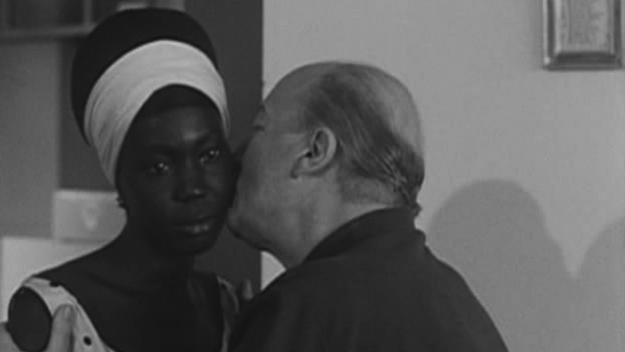
Were there any other actresses you could compare yourself to at the time?
There was no one. But when I was 13, I went to live with a woman in Corsica. I was there for several years. By the time I returned to Senegal, it had gotten its independence. In Corsica, my hostess had known Josephine Baker, so I came to know a lot about Josephine Baker… At the time, if I had had to name an actress, she was probably the only actress I would have been able to think of.
One time, the woman I was living with encouraged me and I wrote a letter to Josephine Baker. She wrote back and sent me a signed photo of herself. She invited me to come to France, though unfortunately I didn’t have the money to go. The Cine-Club combined with the letter from Josephine Baker made me interested to be in the movies. Josephine Baker told me that film was an extremely hard field, but that didn’t discourage me.
Can you describe the Cine-Club?
It rotated between three different movie theaters, though they don’t exist anymore. The theaters were called The Paris, The Palace, and one other whose name I forget… There was some variation depending on the Cine-Club. Some showed French films, classic American films, things like that. There was an organization called the “Actualités Sénégalaises” that included journalists and cineastes… That’s where I had encountered Ousmane Sembene. They showed a lot of documentaries, especially about history and politics. I liked all kinds of films. There was always a discussion after the films. Everyone shared their ideas and opinions—except me, because I was young and one wasn’t supposed to speak out of turn at that age.
What was it like acting for the first time?
It came to me naturally. I didn’t have any issues with anxiety or anything. I enjoyed it. It was a nice change from life as a seamstress. I could have gotten a job at the theater because my uncle was the director of the theater, but I didn’t want to do that. At the School of the Arts, I took some acting classes in order to try something new. The head of the School of the Arts introduced me to Robert Fontaine, my acting professor who became like a father to me. Robert Fontaine was also in Black Girl—he plays my boss in the film.
How long did it take to shoot the film?
More than a month of shooting every day. But I wasn’t tired. We started around 9 a.m. or 10 a.m., and finished around 4 p.m. or 5 p.m. There were quite a few technicians in the crew. Many of them also worked on the news. There were probably five or more people around at any given time. Often we ate meals all together. I knew many of them before the filming. I was always hanging around with intellectuals and some of them were writers or film people.
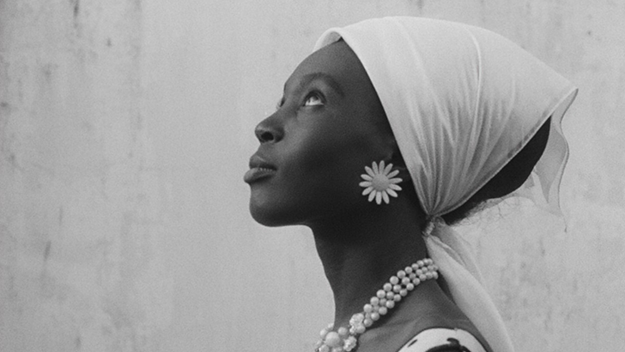
Were there lights or did the production use natural light?
Both. We shot everywhere, everywhere: in the Dakar harbor, in an apartment near the Senegalese Assembly [i.e., the parliament building], at Place de l’Indépendance. We were supposed to go to France, but that never happened, so we had to shoot everything in Dakar!
Sembene would call a meeting with all of us together and tell everyone what to do, and then we would go and do what he told us to do. If the first take was good, he would use that. Sometimes he did a second one to be safe. He didn’t need to do 10 takes for no reason; he knew when he had what he wanted. When the scene went well, he would compliment us.
Since you were a seamstress, did you work on the production’s costumes?
I made all of my own costumes with the exception of the polka-dot dress. That I didn’t make. But I made all the other costumes.
Is the character of Diouana part of a larger feminist struggle?
No, she’s just an individual responding to racism and hatred.
Do you see Diouana’s story as simply the story of an individual, or as an allegory or a metaphor?
Different people can see it differently, but to me she is an individual. This girl was humiliated. She faced racism. Her boss was cruel to her. She was humiliated and humiliated until she killed herself.
I see people as individuals, not by the color of their skin. Racism is wrong. But also, in my life, there have been many things that went awry; but you just have to get up and keep going. You can’t pay attention to every little thing.
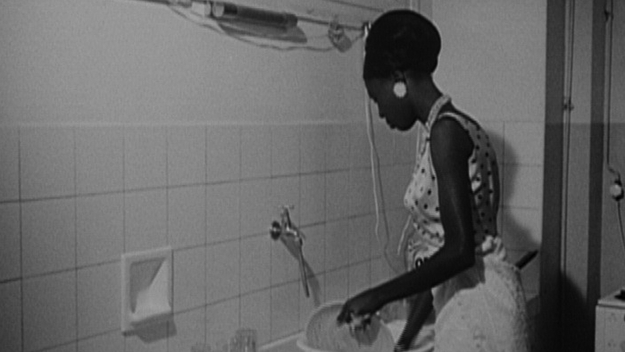
How was the film received?
People were happy. They complimented me. They weren’t expecting it, especially in Africa, but they were pleased. My mother wasn’t happy about it… I don’t know why. My friends congratulated me. Some of them wouldn’t talk to me, but mostly they were happy.
Other artists contacted me afterwards a bit, and I accepted a few films. I did Emitaï [71] with Sembene. But I made sure I kept my seamstress work… because I really liked being a seamstress, too.
How was the bathtub death scene created?
I was wearing a little bikini, though you can’t see it in the film. I was not naked. For the blood, there was a special syrup that we used. We got it from the pharmacy; it was a syrup that people would take when they were sick. On film, it looked like blood.
Was it scary, filming your death scene?
Oh, no. It wasn’t real—it was just cinema.
Special thanks to Dr. Beti Ellerson and Eléonore Martin.



